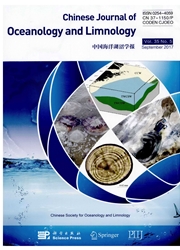

 中文摘要:
中文摘要:
hypoxic 水的大区域最近在华东海被报导了。组织缺氧可能为一些鱼股票的衰落部分负责,这被假设。我们在大黄 croaker (Pseudosciaena crocea ) 上评估了组织缺氧的效果。鱼暴露于溶解的氧的三集中(;1.5 mg/L 和 2.0 mg/L,和 6.5 mg/L 控制) 。我们在 6, 12, 24, 48,和 96 h 暴露以后收集了血。穿血计数,分血器,血红素集中,和在暴露于 1.5 mg/L 的组的吝啬的血球的血红素在 6 h 或 12 h 以后做的红衣服有重要增加,并且推迟的增加(仅仅在 48 h 和 96 h 以后提高了)在这些,在暴露于 2.0 mg/L 的组的索引做。血浆葡萄糖集中在 24 h 以后在两个 hypoxic 组显著地增加了。而且,血浆喂奶并且喂奶在两 hypoxic 在开始的 6 h 暴露以后显著地增加的脱氢酶活动组织。我们的结果建议大黄 croakers 不能维持氧气的小径并且当时,相反为幸存使用厌氧的新陈代谢层次在 2.0 mg/L 下面掉落。我们断定组织缺氧的出现(< 2 mg/L ) 在华东,海能为大黄 croakers 引起新陈代谢的应力并且可能为这种的人口衰落部分负责。
 英文摘要:
英文摘要:
Large areas of hypoxic water have recently been reported in the East China Sea. It is hypothesized that hypoxia may be partially responsible for the decline of some fish stocks. We evaluated the effect of hypoxia on large yellow croaker (Pseudosciaena crocea). The fish were exposed to three concentrations of dissolved oxygen (DO; 1.5 mg/L and 2.0 mg/L, and 6.5 mg/L control). We collected blood after 6, 12, 24, 48, and 96 h exposure. There was a significant increase in red blood count, hematocrit, hemoglobin concentration, and mean corpuscular hemoglobin in the group exposed to 1.5 mg/L DO after 6 h or 12 h, and a delayed increase (only elevated after 48 h and 96 h) in these indices in the group exposed to 2.0 mg/L DO. Plasma glucose concentrations increased significantly in both hypoxic groups after 24 h. Furthermore, plasma lactate and lactate dehydrogenase activity increased significantly after the first 6 h exposure in both hypoxic groups. Our results suggest that large yellow croakers could not maintain the aerobic pathway and instead use anaerobic metabolism for survival when DO levels fall below 2.0 mg/L. We conclude that the occurrence of hypoxia (〈2 mg/L DO) in the East China Sea could cause metabolic stress for large yellow croakers and may be partially responsible for the population decline of this species.
 同期刊论文项目
同期刊论文项目
 同项目期刊论文
同项目期刊论文
 Optimal salinity for dominant copepods in the East China Sea, determined using a yield density model
Optimal salinity for dominant copepods in the East China Sea, determined using a yield density model 期刊信息
期刊信息
